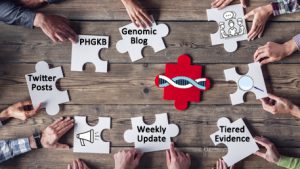Communication and Information Sharing about Genomics and Precision Health: Opportunities for Improvement
Posted on by In this blog, we describe our current approach to information sharing based on a recent review of our communication and engagement strategies. In order to improve our approaches to communication, we are asking you, our readers, for feedback—please share your thoughts in the comments section below or send us an email at mailto:genetics@cdc.gov.
In this blog, we describe our current approach to information sharing based on a recent review of our communication and engagement strategies. In order to improve our approaches to communication, we are asking you, our readers, for feedback—please share your thoughts in the comments section below or send us an email at mailto:genetics@cdc.gov.
For the past two decades, the CDC Office of Genomics and Precision Pubic Health has disseminated information about genomics and precision health to a wide range of audiences, including public health workers, clinicians, researchers, and the general public. A central goal is to identify evidence-based genomic applications that are ready for implementation and to encourage their integration into public health programs and practice. We also hope to educate the general public to benefit from genomic advances and avoid potential harms.
We developed a communication approach that is segmented by audience and scientific evidence level of the genomic application (tiered evidence classification). Specific products include the Genomics and Precision Health Weekly Update; the Genomics and Precision Health Blog; web pages and CDC Features on family history, genomics, and precision health; Twitter posts; and the Public Health Genomics and Precision Health Knowledge Base (PHGKB), which serves as a one-stop-shop for information and publications relevant to genomics and precision health. Below is a table with the types of messages for each of these categories and some selected examples.
| Audience Type | |||
|---|---|---|---|
| CDC public health programs and partners (state and local health departments, health care providers and health systems) | General public | Public health researchers and clinicians | |
| Purpose | To show programs how advances in genomics and precision health can be used to prevent disease and improve health. Strategies include highlighting new data, guidelines, tools, and educational products. | To educate and inform the public about the value of family history, promote selected messages from CDC programs around genetic testing, caution about the potential harms and limitations of genomics, and highlight ethical and social issues. | To share information about the scientific state of the field and knowledge gaps in applying genomics and precision health that can be addressed with additional public health research and evaluation. |
| Tier 1: Genomic applications supported by evidence-based guideline for use in practice | The Tier 1 Genomic Applications Toolkit for Public Health Departments is designed to help state and local health agencies integrate selected tier 1 applications into existing programs and includes customizable materials on hereditary breast and ovarian cancer and Lynch syndrome. | We have developed web pages and CDC Features on selected tier 1 applications, written at a health literacy level appropriate for the general public (e.g. hereditary breast and ovarian cancer, and Lynch syndrome). | The Public Health Genomics and Precision Health Knowledge Base (PHGKB) has scientific information and curated articles that are appropriate for researchers. |
| Tier 2: Promising genomic applications but insufficient evidence for use in practice | We provide information about pharmacogenomics on our website, which is an emerging area for potential use in practice but not quite ready for large scale applications. | We have developed web pages and CDC Features to inform the general public about promising potential genomics applications such as pharmacogenomics. | We have developed blogs about the need for research on clinical validity, utility and implementation about emerging areas such as pharmacogenomics, and PHGKB provides users with the latest resources on these topics.
MyPHGKB provides an opportunity to customize information for researchers. |
| Tier 3: No evidence of validity or utility or evidence of harms | We partner with CDC programs and use our website and blogs to reinforce CDC program messages about selected tier 3 applications that are not yet ready for implementation. Examples include: Direct to Consumer genetic testing and healthy lifestyle and dementia. | We educate consumers and the general public about select tier 3 applications such as Direct to Consumer genetic testing and smoking cessation. | Our blogs provide a description of the need for research and evidence in genomics and precision health. Examples include polygenic risk scores, and whole genome sequencing of newborns.
Our tiered-classified guidelines database provides information on specific genomic applications. |
We note that that most of our communication products can be described as a “push” approach to inform our audiences and spread information. Social media (including blog comments) are an opportunity for a “pull” approach to hear perspectives from various audiences and to engage with our target audiences in order to promote accurate dissemination of information in online spaces. In addition, there are opportunities to adapt our communications by level of health literacy. We recognize that many of our products are geared toward those with high health literacy such as health professionals and researchers, and not the general public.
We would love to have your input on ways you think we could improve our communication to better serve key audiences. What are the best ways to share information? What are the topics and messages you want to learn about? What social media channels do you use to get information about family history, genomics, and precision health? What brought you here to this blog?
Please submit your comments here.
Posted on by


